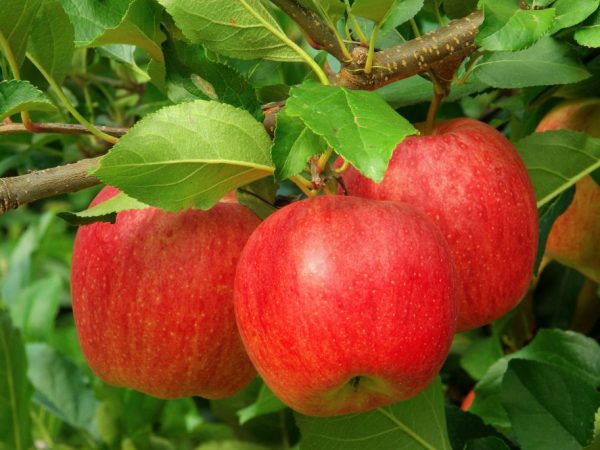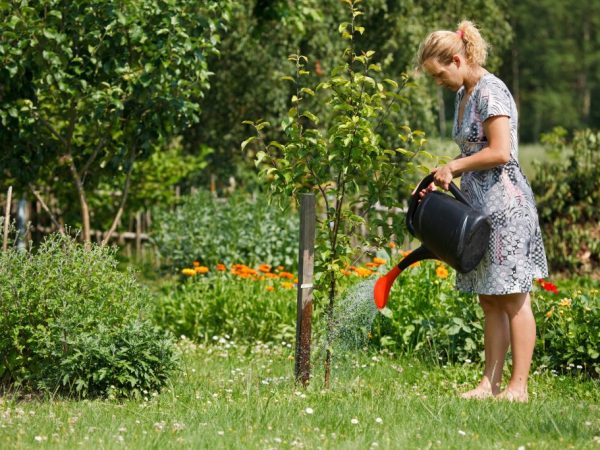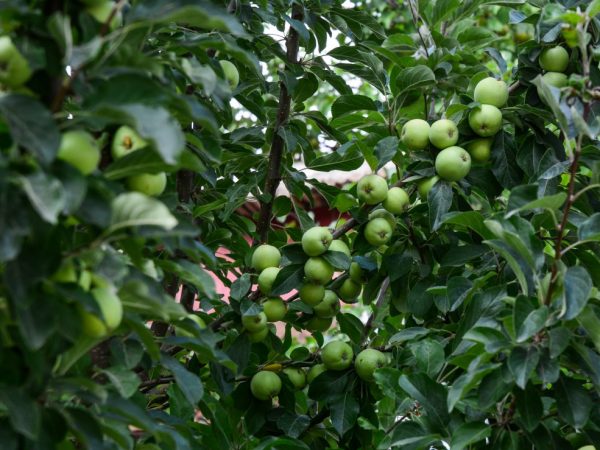Characteristics of the Ligol apple tree
The Ligol apple tree was bred by crossing the Linda and Golden varieties. Polish breeders have created a frost-resistant species with a stable annual yield. The variety is used for commercial purposes: if you compare it with similar crops, then Ligol is profitable to grow, easy to transport and can be stored for a long period.

Characteristics of the Ligol apple tree
Varietal features
The Ligol apple tree is grown in a warm climate - low humidity and hot summers are optimal conditions for it.
At the same time, the variety has high frost resistance. A general description of the culture looks like this:
- early fruit - the first apples appear in the third year after planting;
- average yield - 5 kg per season;
- the rate of increase in productivity is high;
- the type of fruiting is mixed;
- the variety blooms from a week to 10 days.
The fruits are highly resistant to various fungal diseases: they are not threatened by scab and powdery mildew. A tree can suffer from wood diseases - such a problem affects the quality of the crop. Without treatment, the culture dies. The level of resistance to bacterial burns is average.
Description of fruits
The average weight of the fruit is up to 250-270 g. If properly maintained, trees older than three years yield apples weighing up to 400 g. The record holder is a representative of the variety weighing half a kilogram.
Apple fruits are one of the largest among the winter varieties.
They also differ in their beautiful appearance. For this reason, Ligol apples are often grown for sale. Their skin is glossy, it has a light yellow color with red stripes. Most of the time, apples are green until fully ripe.
The calorie content of this variety is 46 kcal.
The shape of the fruit is round-elongated. The base has a characteristic ribbing, and the rest of the skin is lined. The pulp is uniform. Its color is creamy, closer to yellow. The structure is firm and dense.
The pulp is prone to chipping. The funnel of the fruit is straight, but with a slight depression. The variety is distinguished by a small stalk. The taste of the species is good - the pulp is sweet, but with sourness. It has a high keeping quality, which allows you to store the crop for several months.
Description of the tree
Apple trees of this species are large. They are distinguished by a wide crown. The tree is strong with an average growth rate. The crown is conical: its formation occurs in the first three years, after which lateral branches begin to grow. They form an obtuse angle with the trunk.
Branches are rarely intertwined with each other - a large distance is formed from the base. The tree is grown on different rootstocks.
It is characterized by the following properties:
- medium flowering - its total duration is 10 days;
- shoots grow until early July, and under unfavorable conditions, growth continues until the end of summer;
- the period of leaf fall - early October - November.
The height of the tree is from 2 to 4 m.
Growing a tree

Tree health depends on growing conditions
The ovaries of the variety are self-fertile - they need pollinators: for these purposes, species with similar characteristics are chosen. The best options are Spartan or Vitos. Ligol, by the way, is also a good pollinator.
Poorly combined with Idared and Jonagold varieties. Cultivation of a culture takes place according to a simple scheme. After planting, the soil is fertilized, the tree is cleaned (pruned) and the root part is replenished.
The right conditions are created for growing crops. The most suitable soil in terms of mineral composition is loamy. The height of the groundwater is taken into account. If it exceeds 3 m, it is impossible to plant a crop in such a site.
On the ground where weeds grow quickly, it will not be possible to grow a beautiful apple tree: the purity of the root circle must be constantly monitored.
In the spring, loosening of the soil is mandatory at the frequency set by the gardener. In the fall, compulsory work on the site includes collecting foliage around the tree - such simple measures will prevent the development of fungal diseases.
Disembarkation scheme
The Ligol apple tree is planted in two seasons - in autumn and spring. The main condition is that a stable ambient temperature is established.
You can not plant a young tree after the onset of frost. It must adapt to the temperature regime, otherwise it will die.
The soil is preliminarily irrigated: high rates of soil moisture capacity affect the growth rate of the seedling. An additional layer of earth is dug up to increase its air permeability.
The preparation of the soil for planting a seedling takes place according to the following scheme:
- all weeds and roots that remain after old crops are removed on the site;
- a pit of the following dimensions is preliminarily prepared: radius - about 90 cm, depth - no more than 75 cm. It is dug out 2 weeks before the intended planting. Once every two days, the soil is fed with clean water and fertilizers;
- to improve its composition, humus is introduced several weeks before planting;
- after that, mineral fertilizers are applied to the upper layers of the soil - a good mixture for this is humus, ammonium sulfate, ammonium nitrate;
- if planting is planned in the spring, the pit is prepared in the fall - it is dug up and fertilized;
- sand is introduced into clay soil, and clay is introduced into soil with a large amount of sand.
Before planting, which runs vertically, a mixture is introduced into the pit: leaf soil is mixed with peat, humus, compost. Additionally, mineral fertilizers are applied if planting is carried out in spring.
The seedling itself is cleared of dirt and soil lumps. After that, it is immersed in a prepared pit. Soil is poured over the roots, which is carefully laid. A "roller" is made around the pit. It will retain moisture and protect against soil leaching during the rainy season.
Immediately after planting, the tree is irrigated. After that, the frequency of irrigation is established. The formation of the crown is carried out according to any scheme. Over time, for the 2-3rd year, a permanent fertilization system is established.
Care

The apple tree must be fertilized twice a year.
Care for the culture is planned immediately after planting. The first step is to organize the weeding of the soil around the planted trunk.
At the same time, the soil is loosened. Watering begins after the arrival of heat, when a stable temperature is established. In the spring, pruning of excess branches and shoots is carried out.
Twice a year, in order for the apple tree to grow properly, disease prevention is carried out. At the same time, feeding takes place: the quantity and quality of fertilizers depends on the age of the crop. Before winter, it is imperative to protect the tree.
In the spring, as part of the basic care after the winter cover has disappeared, especially in cold regions, soil cleaning is carried out. For this, branches, leaves, debris are removed from the ground around the trunk. After that, she dug over.
Since spring, a mode of digging up the soil is established immediately after watering.Such events are held at least once every 2-3 months. The cleanliness of the trunk circle ensures healthy crop growth.
Irrigation works
Watering is an important step in crop care, especially in the summer. Irrigation of the soil layer is carried out during the following periods:
- during flowering;
- during the formation of ovaries;
- 14-15 days before harvest.
In summer, during a drought, watering can be repeated: only the root part is irrigated. The amount of moisture is regulated depending on the weather conditions of the region in which the apple tree grows. As the tree grows, the amount of moisture introduced increases - the frequency of watering remains the same.
To properly irrigate the trees of the variety, the water is preliminarily settled. To do this, use rainwater or taken from a source. The optimum water temperature is about 20 ° C. Cold liquid promotes the development of fungal diseases and harms the root system of the tree, especially the seedling.
Top dressing
For apples of the Ligol variety, constant feeding is carried out. It guarantees uniform growth of fruits and branches.
Mineral fertilizers and organic matter are regularly applied. The feeding scheme is simple: organic matter is applied no more than 2 times a year - the best time is early spring and late autumn. It is only used after it has settled. Fresh manure cannot be taken. Such feedings can harm the root system.
During the period of active growth, complex fertilizers are applied to the upper layers of the soil. For this, a mixture of phosphorus and nitrogen is used. Top dressing is combined with irrigation.
A stable feeding system is the best option for feeding the root system. If there is an excess of useful additives, the apple tree will bloom later.
With the arrival of autumn and before the first frost, the trunk circle is dug up before fertilization. Lay a thick layer of mulch on top. To prepare natural mulch, humus and peat are mixed in equal proportions.
In the spring, the mulch is removed, watering resumes. A layer of lime is applied to protect the trunk from pests. There is no need to increase the amount of fertilizer, even after the apple tree has suffered a fungal disease.
Diseases and pests
Wood disease, which is characteristic of the Ligol apple variety, manifests itself in the form of black spots on the leaves and bark. To save the tree from danger, a mixture of antibiotics is used. Infected branches or leaves are urgently removed, and the cut sites are treated with antiseptics.
The fruits are not susceptible to powdery mildew, which is a significant advantage of the species. Rodents threaten the harvest, they are fought with the help of simple but proven devices - nets. Roofing material is suitable for such purposes.
Pruning
The growth of the variety is ensured by timely pruning of excess shoots. This procedure is carried out twice - in spring and autumn. Before summer, pruning ensures that the tree grows quickly: broken or dry twigs do not draw moisture from the rhizome.
Autumn pruning provides protection for the tree during the cold season. If there are infected twigs, they can provoke a disease of the trunk or root system.
Spring pruning helps to correct the shape of the crown. In the summer, twigs are removed so that green shoots do not affect the quality of the fruit: if they are not removed, the ovaries will not form correctly, which will lead to the formation of a poor-quality crop.
For this variety, the most successful type of pruning is fusiform. To obtain this type of crown, specific pruning is carried out on a one-year-old seedling.
For this, from the first year, the shoot is shortened by 50 cm. The next year, all shoots are cut, except 3-4 last year. At the same time, one central conductor stands out. The shoot is shortened by half. The scheme is repeated for another 4 years.
Several branches are left stably on the trunk. When pruning, you need to take into account that they should grow evenly and not create shadows for each other. The result is a conical crown shape.After pruning an adult tree, a height of at least 3 m is left.
Harvesting and storage
With proper care and favorable environmental conditions, the apple tree gives a stable harvest at the end of September. The fruits reach full maturity by the beginning of January. At the same time, their sale begins - they stand out among other winter fruits for their beautiful appearance.
The ripe Ligol apple is large and red. Its average weight is 300 g. The fruit acquires the required form within a month. Early harvesting affects only its taste: the earlier the apples are harvested, the more acidity there will be in the pulp.
If harvested in January, the flesh will be softer and sweeter.
No special conditions are needed to store apples. Due to the dense skin, the fruits are stored in a cool room - this does not affect their appearance or taste in any way. The room should be dry: average humidity and low above zero temperature.
The fruits lend themselves to transportation. They do not deteriorate and do not fade for a long period. Stored in wooden boxes. Fruits need fresh air. Apples quickly deteriorate if there are infected or damaged fruits - the fungus quickly spreads to the entire harvested crop.
The fruits are good keeping quality, so they can be stored all winter.
Reviews and recommendations of gardeners
The apple variety Ligol has many positive ratings. It is very popular in Poland, Ukraine and in warm regions of Russia.
Ruddy apples retain their freshness throughout the winter, which is why they are used for sale. The tree does not need heavy care: all that is needed is to organize the correct watering and feeding.
Experienced gardeners advise not to delay pruning and processing branches. Immediately after planting, you need to form a crown. Although the culture is resistant to diseases, it is better to carry out prevention - to clean the leaves, strengthen the trunk.
The secret to growing an apple tree is that it loves free space and warm air. Therefore, a tree is planted in an open area without lowlands and constant flooding.

